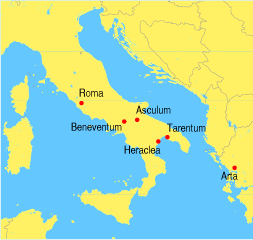Battle of Asculum (279 BCE)
| Battle of Asculum | |||||||
|---|---|---|---|---|---|---|---|
| Part of the Pyrrhic War | |||||||
 Battle sites and places of the Pyrrhic War |
|||||||
|
|||||||
| Belligerents | |||||||
|
Roman Republic Frentani Marsi Marrucini Paeligni Dauni Umbrians |
Epirus Aetolians Acarnanians Athamanians Tarentines Brutti Lucani Samnites |
||||||
| Commanders and leaders | |||||||
|
Publius Decius Mus Publius Sulpicius Saverrio |
Pyrrhus of Epirus | ||||||
| Strength | |||||||
| 40,000 men 300 anti-elephant wagons |
40,000 men 19 war elephants |
||||||
| Casualties and losses | |||||||
| 6,000 killed | 3,500 killed | ||||||
The Battle of Asculum took place in 279 BC between the Roman Republic under the command of the consuls Publius Decius Mus and Publius Sulpicius Saverrio and the forces of Pyrhus the king of Epirus, in Greece. The battle took place during the Pyrrhic War, after the Battle of Heraclea of 280 BC, which was the first battle of the war. There exist accounts of this battle by three ancient historians: Dionysius of Halicarnassus, Plutarch and Cassius Dio. Asculum was in Lucanian territory, In southern Italy.
Cassius Dio wrote that during the winter of 280/279 BC both sides prepared for the next battle. In the spring of 279 BC, Pyrrhus invaded Apulia. Many places were captured or capitulated. The Romans came upon him near Asculum and encamped opposite him. In Plutarch's account, instead, after resting his army, Pyrrhus marched to Asculum to confront the Romans.
According to Dionysius of Halicarnassus, Pyrrhus had 70,000 infantry, of whom 16,000 were Greeks. The Romans had more than 70,000 infantry, of whom about 20,000 where Romans (four legions which at the time had 4,000 men), the rest being troops from allies. The Romans had about 8,000 cavalry and Pyrrhus had slightly more, plus nineteen elephants. The 1st century AD Roman senator Frontinus estimated a strength of 40,000 men for both sides. Pyrrhus had men from Thesprotia, Ambracia and Chaon, two cities and a district in Epirus, and mercenaries from the Aetolians, Acarnanians and Athamanians. These Greeks fought in the Macedonian Phalanx battle formation. He had cavalry squadrons from Thessaly. The Greeks of the city of Tarentum, in southern Italy were allies of Pyrrhus. Pyrrhus also had allies from three Italic peoples in southern Italy: the Bruttii, Lucani and Samnites. Among the allies of Rome mentioned by Dionysius of Halicarnassus there were the Frentani, Marrucini, Paeligni, Dauni and Umbrians. There might also have been contingents from the Marsi, and Vestini, who were also allies of Rome.
...
Wikipedia
